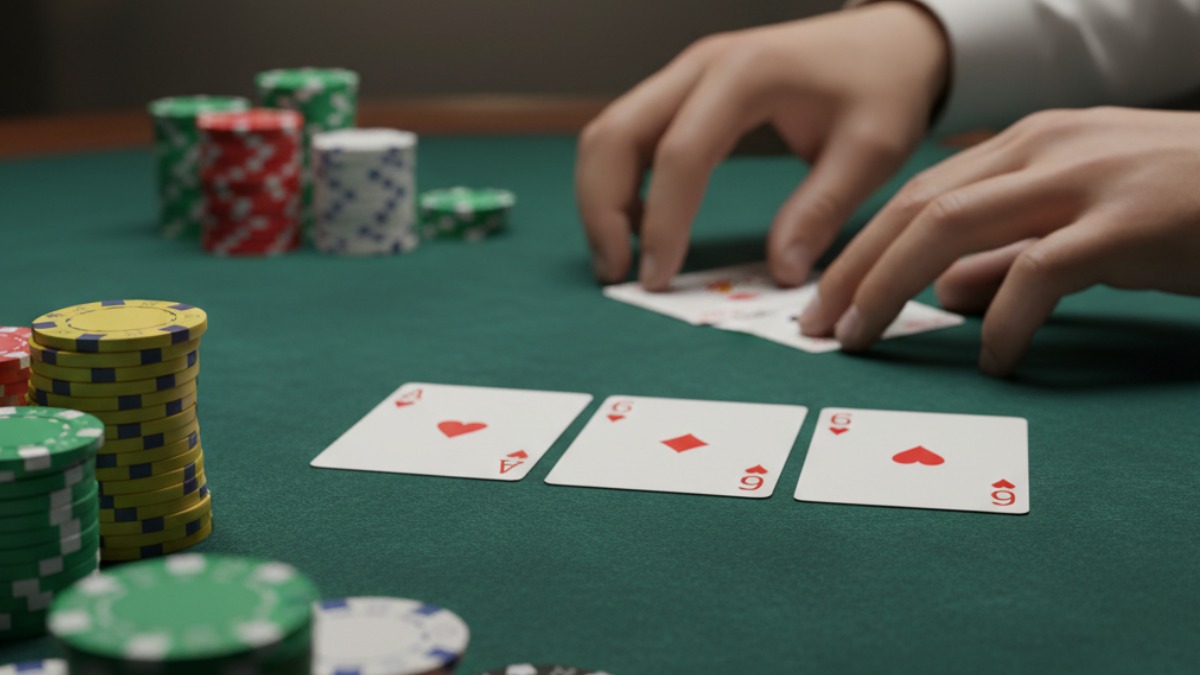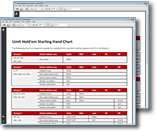
Texas Hold’em Strategy: Perfect Tips for Mastering Your Starting Hands
Every hand of Texas Hold’em begins with a crucial decision: Should I see the flop, or should I fold? This single choice often separates winning players from those who slowly bleed chips away. The secret lies in knowing which starting hands to play—and when.
In this lesson, we’ll explore why smart starting hand selection is the foundation of profitable poker, and what factors should guide your decisions before you commit any chips to the pot.
There are 169 possible two-card starting hand combinations in Hold’em. For simplicity, this treats 
 and
and 
 as the same.
as the same.
If you’re not dealt a pair, your hand will either be suited or unsuited, and connected or unconnected (also called “gapped”). That means every starting hand falls into one of five basic categories:
- Pairs – e.g.

 ,
, 
 ,
, 

- Suited connectors – e.g.

 ,
, 
 ,
, 

- Connecting cards – e.g.

 ,
, 
 ,
, 

- Suited unconnected cards – e.g.

 ,
, 
 ,
, 

- Unconnected cards – e.g.

 ,
, 
 ,
, 

Unconnected cards might be one, two, three-gapped, or more. The bigger the gap, the less chance you have of hitting a straight. For example, if you hold 73, then you’d need a flop of 456 for the straight. But holding T8, you could flop a straight with 9JQ or 679.
The Best Starting Hands in Hold’em
We begin with the strongest starting hands in poker—commonly known as “premium hands.” While debate exists among players over which hands top the rankings, few challenge the dominance of pocket Aces and Kings, the elite pair that anchors the first of three core hand groups.
Group 1: AA, KK

These two starting hands are the major players in hold’em. It’s not often you’ll get dealt Aces or Kings. In fact you get either Aces or Kings once in every 110 hands, so it’s not nearly as often as we’d like. Aces are by far the best possible starting hand in hold’em, closely followed by Kings. However, you should be aware that even Aces or Kings can get cracked, and they don’t play too well against multiple opponents. This means you should definitely be raising pre-flop to narrow the field. Extra caution is necessary when playing Kings, because if an Ace falls on the flop then you’re losing to anyone who has a single Ace in their starting hand. While they are very strong hands which most players love to get, they are certainly not unbeatable.
Group 2: QQ, JJ, AKs

Queens and Jacks rank among the strongest starting hands in poker, offering players a solid chance of holding the best hand at the table. While these premium pairs are still vulnerable to pocket Aces or Kings, they remain favorites against nearly all other holdings. Though you’ll occasionally face opponents with stronger hands, such encounters are relatively rare. These powerful starting pairs should be played assertively—raising is the best course of action to maximize value and apply pressure.
Ace-King is known throughout the poker world as Big Slick, and when suited it’s often called Super Slick. While it isn’t a ‘made hand’, unlike a pair, it offers great potential. It’s only a big underdog to Aces and Kings, and even pairs like Queens and Jacks are only slight favourites. The beauty of AK (suited or unsuited), is that it dominates so many other hands like AQ, AJ, AT, and so on. These types of hands are the ones that players usually end up pushing all-in with late in a tournament.
Group 3: TT, AK, AQs, AJs, KQs

This next group of starting hands is also a strong bunch. You should definitely be looking to raise pre-flop with any of these hands too. We’ve already talked about the power of AK, but starting hands like AQs, and AJs, are also very strong and often run into weaker Ace-X combinations.
Even though these are all strong starting hands, and most of the time you’ll be winning pre-flop, you have to be careful – particularly a hand like KQs, which you can easily fold to a re-raise.
Suited Cards & Suited Connectors
Many beginners defend playing weak starting hands by saying, “but they were suited.” While suited cards can add value, the statistical edge is minimal. The chance of flopping a flush is just 0.8%—about once every 118 hands—and even by the river, your odds only rise to 6.5%. Yes, suited cards are better than offsuit, but not by much. Don’t be fooled into playing marginal hands just because they match in suit—flush potential alone doesn’t make bad hands playable.
That said, suited connectors like JTs, T9s, and 98s can be extremely profitable, but only in the right spots. Their true value comes from implied odds—the chance to win a big pot if you hit a straight or flush. Nonetheless, high suited connectors are far more valuable than low ones, and should be played with caution from early position, small stacked, or against raises.
Kicker Issues
The term “kicker” refers to the smaller of your two cards. Many beginners make the mistake of playing any hand that includes an Ace—such as A♣3♦—without considering how weak the kicker is. This approach often leads to costly decisions.
For example, if you hold A♠6♥ and the flop comes A♦8♣3♠, you’ve made top pair—but any opponent with A9 or better now has you dominated. You’ll win small pots when ahead and lose big ones when behind, which is a losing formula over time.
Key advice: Avoid weak kickers until you understand your position and your opponent’s range. Strong fundamentals—and patience—will save you far more chips than chasing marginal Ace-X hands.
Table Conditions
Hold’em starting hands can be a complex subject because every situation is different. If you were to ask a professional poker player, “should I call, raise, or fold this hand pre-flop?” his response would almost certainly be “it depends!” Here are some of the main reasons why it depends:
The Number of Players
The strength of specific starting hands in poker heavily depends on table size. Hands that struggle against nine or ten opponents gain value as player count drops. For example, a hand like KJ may be risky at a full table but becomes significantly stronger in short-handed play.
Position
Your position on the poker table will be a major factor in deciding which starting hands you should play. The later your position in the betting order, the better – because you get to decide what to do after most of your opponents have acted. We’ll talk much more about the importance of position throughout our lessons on Pokerology, but as a first step please see our lesson on the value of position. Playing position can elude us at first because it is a part of poker that lends itself to be exploited through experience. However, you must quickly realize that your position at the table should heavily influence the choice of starting hands that you play. Until a player has a feel or grasp for positional play, just believe and follow some of the suggestions on the subject.
A Raised Pot
Whether or not a pot has been raised should be a very important factor in your decision to play a particular starting hand. Your selection of starting hands should change when the pot has been raised by a reasonable player.
If there has been a raise and a re-raise before you’re due to act, then you should only consider playing with a very strong hand. Of course this will also depend on the personality types of the other players and whether the game is very loose or passive.
Starting Hand Charts
When you first start playing poker it can be helpful to use a starting hand chart as a point of reference. We’ve created a couple of starting hand charts that can be used by beginners. Please click on the following links to view these charts (they will open in a new window):
Each chart opens as a PDF—you can view it on screen, bookmark it, or print it for quick reference during study sessions or practice play.

These charts are meant to guide your decisions, not dictate them. No single chart can cover every possible table dynamic, opponent type, or game flow. Factors like position, stack size, and player tendencies can all change which hands are profitable to play.
Beginners should start by following the charts closely to build discipline and consistency. As you gain experience, you’ll learn when it’s smart to adjust—tightening up against aggressive players or loosening up in late position, for example.
If a hand isn’t listed, it usually means you should fold. But if you decide to deviate, make sure you have a clear, strategic reason.
Conclusion
One of the biggest mistakes in Texas Hold’em is playing too many hands. Suited cards or any Ace might look tempting, but smart players know discipline wins. Focus on premium starting hands to reduce risk and build consistent profits.
As your skills improve, you can widen your range—but early on, tight play is essential. Overvaluing weak hands leads to costly errors and is a core reason why beginners consistently lose.
In future lessons, we’ll expand much more on the topics discussed in this poker lesson and get you to think beyond the actual cards you’re dealt. We also have hours of video footage covering starting hand selection for both no-limit and fixed-limit hold ’em – so depending upon your preference, be sure to check them out!